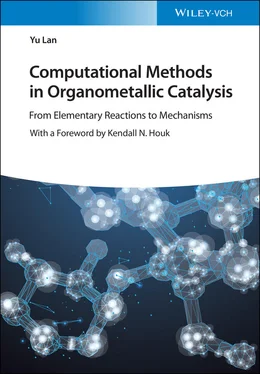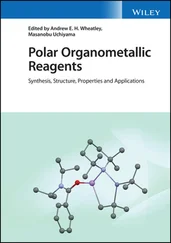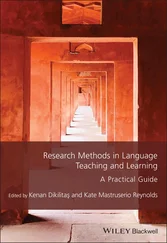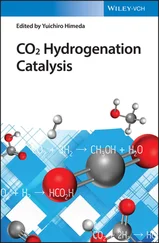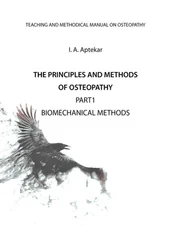Yu Lan - Computational Methods in Organometallic Catalysis
Здесь есть возможность читать онлайн «Yu Lan - Computational Methods in Organometallic Catalysis» — ознакомительный отрывок электронной книги совершенно бесплатно, а после прочтения отрывка купить полную версию. В некоторых случаях можно слушать аудио, скачать через торрент в формате fb2 и присутствует краткое содержание. Жанр: unrecognised, на английском языке. Описание произведения, (предисловие) а так же отзывы посетителей доступны на портале библиотеки ЛибКат.
- Название:Computational Methods in Organometallic Catalysis
- Автор:
- Жанр:
- Год:неизвестен
- ISBN:нет данных
- Рейтинг книги:4 / 5. Голосов: 1
-
Избранное:Добавить в избранное
- Отзывы:
-
Ваша оценка:
- 80
- 1
- 2
- 3
- 4
- 5
Computational Methods in Organometallic Catalysis: краткое содержание, описание и аннотация
Предлагаем к чтению аннотацию, описание, краткое содержание или предисловие (зависит от того, что написал сам автор книги «Computational Methods in Organometallic Catalysis»). Если вы не нашли необходимую информацию о книге — напишите в комментариях, мы постараемся отыскать её.
Computational Methods in Organometallic Catalysis — читать онлайн ознакомительный отрывок
Ниже представлен текст книги, разбитый по страницам. Система сохранения места последней прочитанной страницы, позволяет с удобством читать онлайн бесплатно книгу «Computational Methods in Organometallic Catalysis», без необходимости каждый раз заново искать на чём Вы остановились. Поставьте закладку, и сможете в любой момент перейти на страницу, на которой закончили чтение.
Интервал:
Закладка:
578 583
579 584
580 585
581 586
582 587
583 588
584 589
585 590
586 591
587 592
588 593
589 594
590 595
591 597
592 598
593 599
594 600
595 601
596 602
597 603
598 604
599 605
600 606
601 607
602 608
603 609
604 610
605 611
606 612
607 613
608 614
609 615
610 616
611 617
612 618
613 619
614 620
615 621
616 622
617 623
618 624
619 625
620 626
621 627
622 629
623 630
624 631
625 632
626 633
627 634
628 635
629 636
630 637
631 638
632 639
633 640
634 641
635 642
636 643
637 644
638 645
639 646
640 647
641 648
642 649
Computational Methods in Organometallic Catalysis
From Elementary Reactions to Mechanisms
Yu Lan

Author
Prof. Yu Lan
Zhengzhou University
Green Catalysis Center, and College of Chemistry
450001 Zhengzhou
China
Cover Image: ©Vikks/Shutterstock
All books published by Wiley‐VCHare carefully produced. Nevertheless, authors, editors, and publisher do not warrant the information contained in these books, including this book, to be free of errors. Readers are advised to keep in mind that statements, data, illustrations, procedural details or other items may inadvertently be inaccurate.
Library of Congress Card No.:applied for
British Library Cataloguing‐in‐Publication DataA catalogue record for this book is available from the British Library.
Bibliographic information published by the Deutsche NationalbibliothekThe Deutsche Nationalbibliothek lists this publication in the Deutsche Nationalbibliografie; detailed bibliographic data are available on the Internet at < http://dnb.d-nb.de>.
© 2021 WILEY‐VCH GmbH, Boschstr. 12, 69469 Weinheim, Germany
All rights reserved (including those of translation into other languages). No part of this book may be reproduced in any form – by photoprinting, microfilm, or any other means – nor transmitted or translated into a machine language without written permission from the publishers. Registered names, trademarks, etc. used in this book, even when not specifically marked as such, are not to be considered unprotected by law.
Print ISBN:978‐3‐527‐34601‐1 ePDF ISBN:978‐3‐527‐34605‐9 ePub ISBN:978‐3‐527‐34603‐5 oBook ISBN:978‐3‐527‐34602‐8
Foreword
Computational chemistry began in the 1940s with the earliest electronic computers and drastic approximations to the Schrödinger equation, such as Hückel molecular orbital theory. Since the 1960s, the possibilities of doing quantum mechanics calculations on large systems containing metals, indeed to study the heart of organometallic chemistry, began with the Mulliken–Wolfsberg–Helmholtz approach and then Roald Hoffmann's Extended Hückel Theory (EHT) in the 1950s and 1960s. While an amazingly useful method, EHT is really only of qualitative value. But actually what we need is a conceptual framework that is useful even today.
The 1960s saw remarkable advances in methods, approximations, and the beginnings of the flowering of computers for chemical calculations. The dawn of the modern hybrid density functional theory in the mid‐1990s, borrowing exact exchange from wavefunction theory, made it possible to begin the quantitative calculations of structure, mechanics, and mechanisms, including the incredibly useful organometallic reactions. Both Ru and Mo catalysts for olefin metathesis, and Pd catalysis for cross‐coupling reactions, have led to Nobel prizes for their discoverers.
Yu Lan has now written an introduction, a guide, a masterwork about quantum mechanical studies of organometallic reaction mechanisms. He is ideally equipped to write such a book, already doing outstanding work in the field as a student and postdoc, and becoming a leader in the field in his independent career. He has also trained many young experts in the field, and his influence will spread further from their achievements and through this book.
The book includes a historical introduction to organometallic chemistry, a survey of mechanisms, and an extensive introduction to quantum mechanical computational methods, especially density functional theory, as well as programs for quantum chemical calculations.
The description of organometallic structures and mechanisms is peppered with numerous calculations from the Lan group with relatively accurate density functionals. Part 2, the bulk of this book, is organized with a chapter for each of the most important metals used in organometallic chemistry: Ni, Pd, Pt, Co, Rh, Ir, Fe, Ru, Mn, Cu, Ag, and Au. The computational studies of the reactions of complexes of each of these metals are reviewed with great insights into mechanisms using computations.
The book will be a boon to organometallic chemists and computational chemists involved in the study of organometallic reactions. While a number of books on organometallic chemistry mechanisms are available, this is THE book describing the methods for computation and analysis of organometallic reactions using modern quantum mechanical methods.
29 August 2020
Kendall N. Houk
Preface
A long time ago, when I first came into contact with science, I was fascinated by the unique charm of organic chemistry. The tetravalent carbon atoms and their tetrahedral structures impressed me with elegant simplicity. Through the broken and formation of covalent bonds, various new molecules that possess unique properties could be generated. By manipulating the reaction conditions, catalysts, and ligands in organic reactions, chemists can effectively synthesize plenty of complex natural product molecules and pharmaceutical molecules in high regioselectivity and enantioselectivity. When I was a teenager, I took every organic chemical reaction as a puzzle, and the reaction mechanism is like the answer to the puzzle. In this way, I found great pleasure in thinking about the mechanism of organic reactions. The development of organic chemistry also requires a comprehensive mechanistic understanding. Generally, a significant amount of information about reaction mechanisms could be obtained by experimental techniques. However, the experimental mechanistic study mainly focuses on the macroscopically observed experimental phenomena. Therefore, in many cases, pure experimental observation is not sufficient for revealing the complete reaction pathway and clarifying the origin of selectivity. During my doctoral study at Peking University, I was fortunate to work with my supervisor Professor Yun‐Dong Wu, from whom I learned how to use computational chemistry to investigate the organic reaction mechanisms. Theoretical calculations based on quantum mechanics, especially the density functional theory calculation, have constituted the most powerful tool for mechanistic study due to the development of supercomputer, computational theory, and corresponding software.
In the past several decades, one of the most important advances in organic chemistry has been the introduction of transition metal catalysts to organic synthesis. Transition metal species can react with organic compounds to generate intermediates that contain carbon–metal bonds. Subsequent conversion of these organometallic intermediates could enrich the synthetic approach toward new molecules. Different from organocatalysis, the organometallic catalysis usually goes through multiple steps and complicated catalytic cycles, which originated from the complex bonding pattern of organometallic catalysts and the variation of valance state of the central metal species. Thus, the utilization of theoretical calculation for understanding the reaction mechanism is imperative for the development of organic chemistry. My post‐doctoral research with Professor K. N. Houk was working with experimental chemists to explore the mechanism of organometallic reactions through the collaboration of theoretical calculation with experimental study. The promotion of theoretical study on experimental development could be summarized into “3D,” i.e. description, design, and direction. Based on the data obtained from experimental study, detailed descriptions of the organometallic reaction mechanisms could be fulfilled using theoretical calculation. The mechanistic study then provides further theoretical guidance for the rational design of new reactions, which points out the direction of experimental development.
Читать дальшеИнтервал:
Закладка:
Похожие книги на «Computational Methods in Organometallic Catalysis»
Представляем Вашему вниманию похожие книги на «Computational Methods in Organometallic Catalysis» списком для выбора. Мы отобрали схожую по названию и смыслу литературу в надежде предоставить читателям больше вариантов отыскать новые, интересные, ещё непрочитанные произведения.
Обсуждение, отзывы о книге «Computational Methods in Organometallic Catalysis» и просто собственные мнения читателей. Оставьте ваши комментарии, напишите, что Вы думаете о произведении, его смысле или главных героях. Укажите что конкретно понравилось, а что нет, и почему Вы так считаете.
